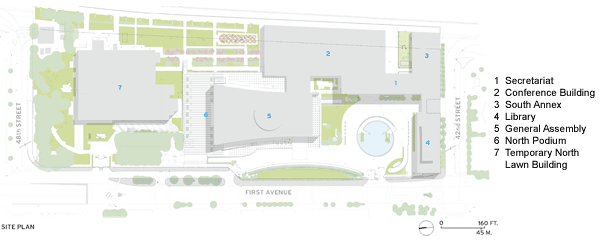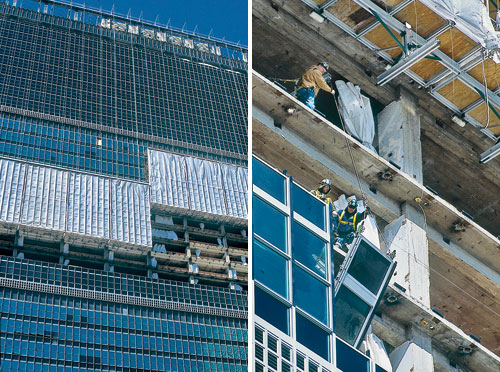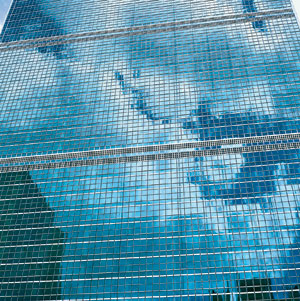Revival of an Icon
The original design-team members were not oblivious to the problems associated with their orientation choice, however. Le Corbusier argued for an envelope solution that included external shading devices, such as the brise-soleil that had been installed on his 1933 Salvation Army project in Paris several years after its completion. Harrison, meanwhile, advocated the use of insulated glazing, a new technology consisting of two layers of glass with a sealed air space in between. The U.N. originally chose insulated glazing based on a cost study by the mechanical-engineering firm Syska Hennessy (which, coincidentally, is also the mechanical engineer for the U.N. renovation). The study showed that the new glazing technology would be less expensive and easier to maintain than the combination of conventional glazing and an external shading system. However, the insulated glass was also eventually eliminated from the specifications, not only due to its cost premium over single glazing but also because the layered glass was too heavy for the double-hung sashes. Its international design team notwithstanding, the Secretariat “fell victim to that uniquely American practice affectionately known as 'value engineering,' ” says Heintges.
 |
|
Plan: Courtesy U.N. Capital Master Plan |
The glare and heat-gain problems were most acute on the building's east side, which faces the East River. Here, almost immediately after the building's opening, the U.N. installed a reflective film to the inside of the vision glass. (A different type of adhesive film was applied to the Secretariat's west facade—which is partially shaded by Midtown Manhattan's mass of buildings—but not until after the 9/11 attacks in response to heightened security concerns.) The east facade's reflective film helped reduce the solar load, but it also radically altered the Secretariat's appearance, eventually bubbling, wrinkling, and peeling. And because the glazing was simply annealed (meaning it had not been heat-treated), the film also induced thermal stresses, causing the glass to break. As the panels cracked, they were replaced with glazing of various types, creating a jumble of different hues and degrees of transparency.
The spandrel panels also suffered from occasional breakage. And although the originals were made of tinted wire glass, they were replaced in some places with clear glass and in others places with nonwire, laminated glass containing a blue-green PVB (polyvinyl butyral) interlayer intended to approximate the original tint. Behind the spandrels, paint began peeling from the concrete-block knee walls, revealing the masonry joints through the glass.
 |
Demolition of the original curtain wall (above left) and installation of the new one (above right) proceeded from bottom to top in each of the roughly 10-story zones defined by the tower’s louvered mechanical levels. Photography: © William Ravelli |
 |
The new cladding incorporates numerous performance enhancements, including a low-E coating and blast resistance. Photography: © William Ravelli |
The glazed portions of the curtain wall were not the only sources of problems. The system as a whole suffered from air and water infiltration and condensation, resulting in energy loss and occupant discomfort, and creating ideal conditions for deterioration of the facade's structural components. And there were visible signs of such damage, like bulging mullion covers—an indication that the steel behind the aluminum was rusting. So in 2002, the U.N. authorized an inspection program that included borescopic investigation of the mullions performed from the building's interior and more extensive probes of the exterior conducted from a swing stage. The latter focused on areas deemed representative of the whole enclosure system and entailed the selective removal of spandrel panels, extrusions, and flashing. About 97 percent of the anchors inspected exhibited some form of corrosion, and 54 percent had significant corrosion.
The U.N. and its consultant team considered repairing the Secretariat curtain wall, restoring it to its original condition, and a strategy that Heintges calls “faithful reconstruction.” The last option, which is the one they ultimately chose, involved complete replacement of the curtain wall with a state-of-the-art system that would closely match the look of the 1950s materials, replicate their profiles, and realize the original design intent. Replacement, they concluded, would be the only way to meet heightened security standards, maintain comfortable interior environmental conditions, and conform to energy codes—codes the U.N. says it is voluntarily complying with, and in many cases exceeding, even though it is not bound by local zoning or building regulations. “We want to be good citizens and responsible owners, even though we are on sovereign territory,” says Adlerstein. The U.N. predicts that the facade, along with features such as daylight dimming, demand-control ventilation, and a sophisticated building-management system, combined with campus-wide improvements like the revamp of the central plant, will cut the compound's energy use by 50 percent.









